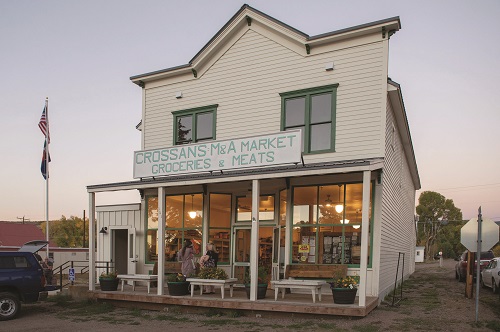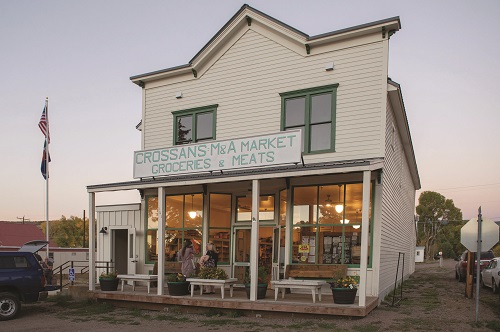Fresh Spaces: Repurposing Historic Buildings Yields Economic Rewards
Adaptive-reuse projects buoyed by tax credit program
Margaret Jackson //March 6, 2019//


Fresh Spaces: Repurposing Historic Buildings Yields Economic Rewards
Adaptive-reuse projects buoyed by tax credit program
Margaret Jackson //March 6, 2019//

Developers have been finding new uses for old buildings for decades. It’s a key factor in preserving a community’s history and retaining its character.
“Historic preservation is about preserving places and adapting them to create a sense of place,” says Jennifer Orrigo Charles, executive director of Colorado Preservation Inc. (CPI). “It’s not like a new development that looks like everything in every other place. It tells that history of the community and grounds you where you are.”
Repurposing old buildings also has significant economic benefits. Every $1 million spent on historic preservation leads to $1.03 million in additional spending, 14 new jobs and $636,700 in increased household incomes, according to a study conducted by CPI, Clarion Associates and History Colorado.
But most historic preservation or adaptive reuse projects would not be possible without the help of Historic Preservation Tax Credits. Colorado’s existing tax credit program was expanded with the Colorado Creation and Main Street Revitalization Act in July 2015. Since the program began, developers and preservationists have spent $120.6 million on tax credit rehab projects across the state. The projects have added affordable housing units, restaurants, community gathering spaces and art spaces.
Applicants to the program estimate that 661 new full-time jobs will be created as a result of the economic development generated by their rehab projects. Stanley Marketplace, for example, is a community of more than 50 businesses located inside the former Stanley Aviation facility in Aurora. Completed in 2016, the $25 million project, which received $2 million in State Historic Preservation Tax Credits, has created more than 200 jobs.
The historic tax credit program was set to expire in December 2019, but Gov. John Hickenlooper signed the reauthorization of the act earlier this year, extending it for an additional 10 years at $10 million annually, with $5 million dedicated to small projects and $5 million set aside for large projects.
Among the most significant examples of adaptive reuse is repurposing historic schools, says Charles, whose office is located inside the former Emerson School in Denver’s Capitol Hill neighborhood. The former school also is home to The National Trust for Historic Preservation’s Denver Field Office and Historic Denver.
Charles cites the Ivywild School, built in 1916 just south of downtown Colorado Springs, as a perfect example of a successful adaptive reuse project. The school, which shut down in 2009, was purchased in 2012 with the goal of restoring the historic centerpiece of the neighborhood.
Today, the school is home to a marketplace with tenants including The Principal’s Office, which serves beverages like Ethiopian espresso and handcrafted cocktails; Axe & Oak Whiskey; Old School Bakery; and Bristol Brewery & Pub. In addition to bars and restaurants, the former school houses Yobel Market and office space for Mammoth Digital, a full-service marketing agency.
“A lot of these old school buildings are threatened,” Charles says.
In 1997, CPI created Colorado’s Most Endangered Places Program to build awareness and provide assistance to historically significant places throughout the state. Among the success stories is Crossan’s M & A Market in the heart of Yampa. Built in 1903, the market served Yampa as a general store for 61 years until the business closed in 1964 and the building slowly deteriorated.
The town of Yampa bought Crossan’s in 2006, and the Friends of Crossan’s M & A Market committee formed in 2011 with a mission of saving the building. The rehabilitated Crossan’s, which opened in September, includes a community meeting room, space for the Northwest Colorado Cultural Heritage Program and a visitor’s center that houses exhibits open to the public. There is also a research and genealogy center for people interested in exploring personal connections to the region’s past.
“Retaining historic buildings promotes the experience of place and celebrates what makes statewide towns and communities different,” Charles says.
Historic preservation has become so significant that commercial real estate professional organization CCIM Institute released a report that looks at adaptive reuse projects as a distinct asset class. Adaptive reuse constitutes up to 2 percent of all U.S. commercial real estate space today, according to the CCIM report, “Adaptive Reuse: Turning Blight into Bright.” That figure is likely to increase twofold over the next five years, largely as a result of store and mall closings.
Larimer Square, perhaps Denver’s most famous preservation project, was added to the national list of America’s 11 Most Endangered Places for 2018. As Denver’s first commercial block and first historic district, Larimer Square has been a national model for revitalizing neighborhoods through preservation, according to the National Trust for Historic Preservation. But now it’s threatened by what the trust calls an “inappropriate development proposal” that calls for partial demolition of several buildings, the potential construction of two towers and weakening the ordinance that has protected the famous block.
Preservationist Dana Crawford, who saved Larimer Square from the wrecking ball in the 1960s, says that while adaptive reuse projects are difficult, saving historic buildings is worth the effort to maintain a city’s character.
“Do people want to live in plywood boxes, or do they want to live in a community that is known for excellence?” says Crawford, who is working on repurposing several historic buildings in Trinidad, about 180 miles south of Denver. “I think adaptive reuse projects are important if people want a good quality of life.”






















